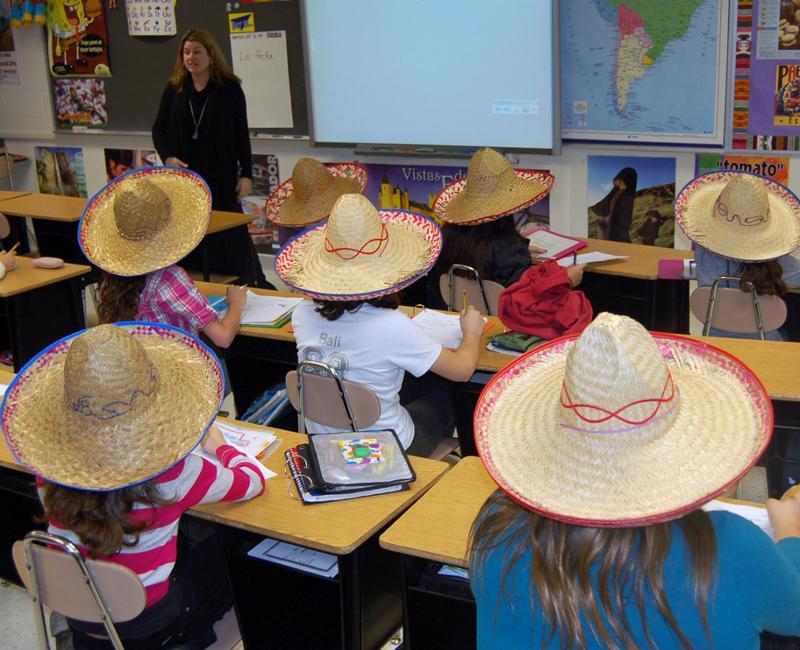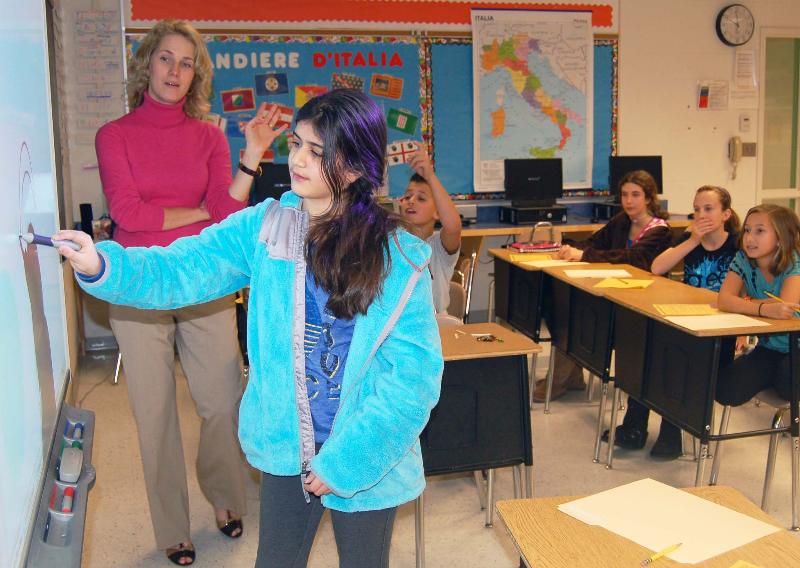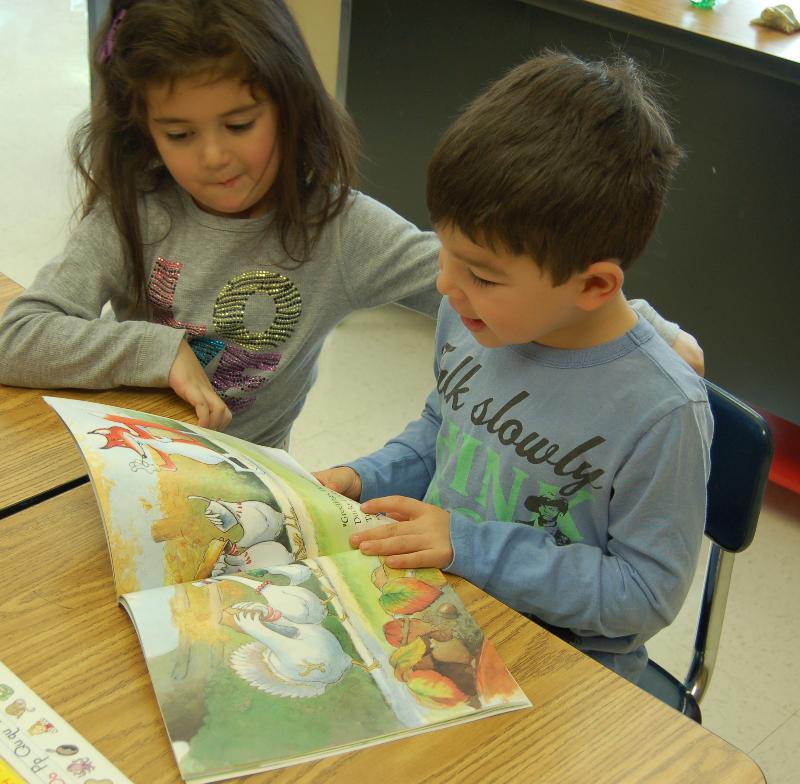|
December 2011, Vol. 2: Issue 1 |
|
|
|
Wampus Nature Trail Takes the Classroom Outdoors
|
For Wampus third graders, there's no limit to the things to be learned from nature. The school's nature trail, which meanders through the woods and wetlands between the middle school and Wampus, provides ample opportunity for multi-disciplinary lessons.
 | |
Wampus principal Debi Cagliostro helps
Craig Buonanno and Leah Sokol practice measuring. See more photos.
|
"Almost anything can be taught during our walks," says third grade teacher Sasha Davies, who, rain or shine, takes her students out on the nature trail every week. She lists some of the many things her students learn about outdoors: "Weather, earth science, technology, art, writing, current events, sustainability, collaboration."
Anne McKeown's third graders go out every two weeks throughout the year, looking, listening and touching, and, like all good stewards of the land, leaving it just as they found it.
"The basic premise really is observation: looking at how things change over time," she says. Her class was out recently with probes assessing the effects of sunlight on temperature, and practicing measuring. "It gives us an opportunity for more practice of what we're doing in the classroom and makes things more relevant to the children's world," she says.
The nature trail, restored with the help of funding from the Byram Hills Education Foundation, has inspired her students in many ways. They've created Haiku poems, which for a time were posted on the 12 stations that mark the trail. "It's a really good place to generate new ideas for writing," she says.
It's inspirational for Ms. Davies's students, too, who write about it to their pen pals in Key West, Florida. "The foundation of our letter and email exchanges are built around our walks on the trail and theirs at the seashore - comparing and sharing nature in each of our worlds," she says.
The nature trail was recently the springboard for a civics lesson for Ms. Davies's students, who sent a letter to the editor of The Journal News regarding proposed cuts to county-funded nature centers. "My students learned that they have a voice to express their concerns regarding their community and the land," she says.
There's also a completely practical benefit to the outings. Says Ms. McKeown: "Any time the students can move around and get fresh air is good. It really wakes them up and makes it easier for them to come back and do a math lesson. They'll settle down more quietly and get to work."
|
|
|
| A Note from the Superintendent |
Dear Byram Hills community members, At this season of giving and love of family and friends, I wish you peace and a wonderful holiday. Sincerely, Dr. Jackie Taylor |
|
HCC Program Helps Sixth Graders Choose a Language
|
"It's amazing how much you can squeeze into 18 days," says World Languages coordinator and 6th grade Linguistics teacher Melissa Stahl, who is discovering how receptive sixth graders are when it comes to absorbing facts about languages. The Linguistics class, a new addition to the Crittenden Arts Cycle this year, is exposing students to the value and nuances of language and the system of rules that languages follow.
 | | Sombreros are optional in Heather Luis's Spanish classes.
|
Linguistics is one section of the Arts Cycle, which gives students an 18-day exposure to a range of art, health, technology and language electives. The language segment ensures that all students sample the three languages that the school district offers through high school - French, Spanish and Italian - to help them make an informed choice of the language they want to study.
It's an important decision. New York State requires students to have two years of language study to graduate (seventh and eighth grades are considered one language credit) but most Byram Hills students go on for three or four language credits. To ensure that students have the option of taking a language at the Advanced Placement level (a fifth year of language credit) and because colleges are looking for four or five years of language credits, it is important for middle school students to be thoughtful about the language they choose and comfortable with their decision.
French teacher Nancy Sarro, now in her 20th year at Crittenden, saw the introduction of the language rotation about 14 years ago. "I do think that it is very important for the children to experience the three languages and linguistics. It absolutely helps them make a better call on language selection."
During their 18-day study of each of the three languages, students learn weather expressions, date and time and basic greetings. "They get to see how the language sounds, how the pronunciation feels," says Ms. Stahl. "They're also exposed to the cultures where these languages are spoken."
Many students, for example, are surprised to learn that French is spoken in more than 30 countries and that, along with English, it's the official language of the United Nations and the Olympics.
Ms. Stahl, who teaches language at the high school, says the Crittenden language exploration has another benefit. She frequently hears her high school students singing the songs they learned in sixth grade language exploration. "The language rotation sets a nice positive foundation to the language learning experience."
 | | Priya Tewani at work in Melissa Stahl's Linguistics class, part of the language rotation all sixth grade students take. |
|
|
Please forward this email to anyone who you think would enjoy it and who might like to join our mailing list.

|
|
|
|
|
Peer Leaders Give Straight Talk on Health |
Standing in front of a class of 27 sophomores recently, Byram Hills High School seniors Deanna Williams, Kayla Anfang and Ilana Dunn had everyone's attention. Members of the school's Peer Leadership Program, the three were giving a lesson on alcohol use and abuse and its consequences.
The class was attentive and respectful.
The three are among 15 trained peer leaders who assist high school health teacher Mark Levine in getting important messages through to his students. Unique in having seniors teach an entire semester of sophomore health classes, the Peer Leadership Program at Byram Hills High School dovetails with the school's belief in encouraging leadership, service, and students helping other students.
 | | High School senior Deanna Williams, a peer leader, talks to sophomores about drug use and abuse. See more photos. |
"We know that peers have great influence over each other, and in matters that students really relate to - health, drugs, alcohol and sex education - we've found that peer education is the best way to really get the facts across," says Mr. Levine.
During a recent class addressing alcohol, students Sarah Michaels and Alec Guberman agreed that learning about these things from high school peers is preferable to learning them from adults.
Selected for their leadership and interpersonal skills and for their commitment to be role models, the peer leaders undergo a semester of training with Mr. Levine to cover leadership and lesson plans. They work in groups of three or four, and are assigned a class of sophomores to teach for the semester. Topics include the physical effects of alcohol on the body, heart disease, AIDS, drugs, stress and mental health.
As the peer leaders led a recent class with a PowerPoint presentation on alcohol use and abuse, the three seniors were clearly well prepared. They spoke frankly and knowledgably and involved the sophomores in an assignment examining the topic. The younger students took the class seriously, listening respectfully and participating in the task.
The program benefits are not just for the younger students. Peer leaders earn an elective credit for their participation, and learn much from the program. "I got more out of it than I expected," says Deanna. "Having to teach a class has given me so much confidence as a public speaker."
A significant added value to the program is what happens outside the classroom. The peer leaders say they develop friendships with their students who frequently turn to them outside of school. "Kids are very open and willing to come to us," says Kayla. Ilana agrees: "I never expected people to trust me in this way. It's a really great feeling."
In his 23 years of running the Peer Leadership Program, Mr. Levine says its value has been repeatedly proven. "We're talking about issues that teens deal with all the time, and what better source is there than other teens?" |
|
Repetition and Memorization: All Part of Learning to Read |
 | Coman Hill kindergarteners "read" a book they have memorized.
|
If you ever wondered if there was any value in reading the same book to your emergent reader over and over again, put your mind at rest.
"An important part of learning to read is memorizing text on a page," explains Coman Hill kindergarten teacher Danielle Wall. "It allows children to look at a picture and 'read' the story. Emergent readers can 'read' more complex books than the Run, Jane, Run genre; it keeps them interested and wanting more."
An increased understanding of this aspect of the learn-to-read process has made it part of the kindergarten day at Coman Hill. Each kindergarten class has a collection of Star Books, after which the program is named, carefully chosen for memorizing, rather than for decoding to read. The books, which include some old-time classics like The Three Little Pigs as well as modern texts, appear far too wordy for emergent readers, but students use the pictures on each page as prompts.
Introduced last year, Star Books has been a hit with Coman Hill kindergarten teachers and students. Ms. Wall says her students are much more engaged and enthusiastic at reading time. "They feel part of the reading community and have a sense of freedom about reading without working at decoding words."
Up to half an hour three or four times a week is devoted to Star Books. The teacher first reads a book to the class, which then breaks down into pairs by ability, for reading from the collection. This allows children to read at their own level to work on the skills they need to develop.
While being a big confidence builder (very important for the emergent reader), Star Books reading also develops comprehension skills, helps build vocabulary and creates an awareness of punctuation. "This is a very natural way for children to learn to read. Family favorites get re-read repeatedly at home, so it works there too," says Ms. Wall.
A recent lesson worked on reading with expression with children being encouraged to take cues from text font size and punctuation as well as the illustration. So, when a student sees SOMEBODY HAS BEEN TASTING MY PORRIDGE! in big, bold text in The Three Bears, they immediately understand this is to be read very loudly. "It allows the children to bring the story to life so that they don't read robotically," says Ms. Wall.
While decoding skills are taught during another part of the school day, educators believe the Star Books concept goes a long way in developing stronger readers. Ms. Wall certainly agrees: "It's a fantastic program. I definitely noticed a difference." |
|
Our Mission
In an environment of mutual respect, the Byram Hills School District and its community will provide students with the means, the knowledge, and the opportunity to excel in order to become productive and responsible citizens of the twenty-first century.
"A great place to learn."www.byramhills.org
|
|
|
|
|